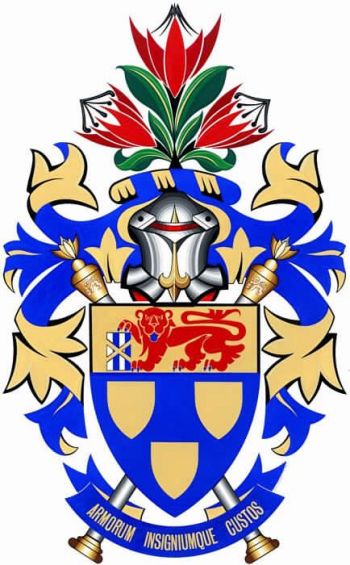Bureau of Heraldry
| Heraldry of the World |
| South Africa heraldry portal Civic heraldry of South Africa |
|
BUREAU OF HERALDRY
Official blazon
- (af)
Wapen: In blou, drie skildjies van goud, geplaas 2 en 1, en 'n goue skildhoof belaai met die Suid-Afrikaanse leeu (te wete, die leeu soos voorgestel in die helmtekens van die Wapen van die Republiek van Suid-Afrika).
Helmteken: Op 'n wrong van goud en blou, 'n proteatak et drie blomkoppe en blare, alles van natuurlike kleur.
Wrong en Dekklede: Goud en blou.
Heroutstawe: Die voorstelling as geheel geplaas oor twee skuinsgekruiste heroutstawe van goud.
Wapenspreuk: ARMORUM INSIGNIUMQUE CUSTOS
- (en)
Arms: Azure, three escutcheons Or, placed two and one, and on a chief Or the South African lion (to wit, the lion as presented in the crest of the coat of arms of the Republic of South Africa).
Crest: On a wreath Or and Azure, a branch of Protea containing three flower-heads and leaves, all proper.
Wreath and mantling: Or and Azure.
Batons: he representation as a whole superimposed on two batons placed in saltire, Or.
Motto: ARMORUM INSIGNIUMQUE CUSTOS
Origin/meaning
The arms were officially granted on March 26, 1966.
The three gold escutcheons clearly symbolise the Bureau’s function of creating and registering coats of arms. The lion in the chief is taken from the crest of the Republic of South Africa (as used from 1961 to 2000), symbolising the authority of the State under which this is done.
The lion holds four staves, two silver (white) and two blue, bound together with a golden cord.
The flowers in the crest are simply named as Protea, which means they could belong to any of a number of species of this genus. They quite definitely are not Protea cynaroides, the national flower. They closely resemble Protea eximia, a species found widely in the fynbos region between Worcester and Port Elizabeth, and have some resemblance to Protea magnifica, the natural range of which is in the western mountains from Pakhuis Pass in the Cedarberg to Houw Hoek in the Boland mountains.
In the older version of these arms, which in the Bureau’s earlier days appeared on all certificates of registration, the proteas were drawn much more like Protea cynaroides.`
The diagonally crossed batons in front of which the arms are placed symbolise the office of herald.
The motto translates as “Custodian of arms and insignia” – which, in short, is the Bureau’s function.
Contact and Support
Partners:
Your logo here ?
Contact us
© since 1995, Heraldry of the World, Ralf Hartemink 
Index of the siteLiterature: Information provided by Mike Oettle.












